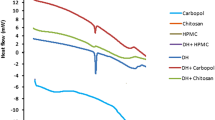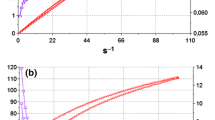Abstract
Purpose. There is accumulating evidence that neurogenic mediators such as substance P (SP) and α-melanocyte stimulating hormone (α-MSH) contribute to inflammation following chemical and thermal injuries or in disease conditions such as psoriasis and contact dermatitis. Spantide II is a peptide with a molecular weight of 1670.2 which binds to neurokinin-1 receptor (NKR-1) and blocks proinflammatory activities associated with SP. The aim of this study was to investigate in vitro permeation and distribution of spantide II through hairless rat skin and the anti-inflammatory effect of topically delivered spantide II in an allergic contact dermatitis (ACD) mouse model.
Methods. The in vitro permeation and distribution of spantide II with or without cysteine HCl (CH) as a penetration enhancer through hairless rat skin was studied using Franz diffusion cells. The anti-inflammatory effect of spantide II was studied by measuring the reduction of ACD in C57BL/6 mice after application of spantide II as a topical solution.
Results. The skin permeation experiments with or without cysteine HCl (as penetration enhancer) showed no detectable levels of span- tide II permeation across rat skin over a period of 48 h. Cysteine HCl significantly increased the distribution of spantide II in skin layers; also, the reduction in ACD response was significantly higher with the formulation containing cysteine HCl (p < 0.05). Spantide II at different concentrations showed a dose-dependent reduction of ACD response in mice.
Conclusions. The current study demonstrates that spantide II can effectively be delivered to epidermis and dermis to exert a significant anti-inflammatory activity on the reduction of inflammation in a mouse model of ACD.
Similar content being viewed by others
REFERENCES
K. Seiert and R. D. Granstein. Neuropeptides and neuroendocrine hormones in ultraviolet radiation-induced immunosuppression. Methods 28:97-103 (2002).
J. C. Ansel, A. H. Kaynard, C. A. Armstrong. J. E Olerud, N. W. Bunnett, and D. G. Payan. Skin-nervous system interactions. J. Invest. Dermatol. 106:198-204 (1996).
J. E. Parrillo and A. S. Fauci. Mechanisms of glucocorticoid action on immune processes. Annu. Rev. Pharmacol. Toxicol. 19:179-201 (1979).
A. N. Anigbogu and H. I. Maibach. Topical corticosteroid therapy. In L. Millikan (ed.), Drug Therapy in Dermatology, Basic and Clinical Dermatology. Marcel Dekker, New York, 2000, pp. 1-29.
T. E. Scholzen, T. Brzoska, D. H. Kalden, F. O'Reilly, C. A. Armstrong, T. A. Luger, and J. C. Ansel. Effect of ultraviolet light on the release of neuropeptides and neuroendocrine hormones in the skin: mediators of photodermatitis and cutaneous inflammation. J. Invest. Dermatol. Symp. Proc 4:55-60 (1999).
J. R. Brown, P. Perry, S. Hefeneider, and A. C. Ansel. Neuropeptide modulation of keratinocyte cytokine production. In P. Oppenheim and D. Kluger (eds.), Molecular and Cellular Biology of Cytokines. Wiley-Liss, New York, 1990, pp. 451-456
T. Andoh, T. Nagasawa, M. Satoh, and Y. Kuraishi. Substance P induction of itch-associated response mediated by cutaneous NK1 tachykinin receptors in mice. J. Pharmacol. Exp. Ther. 286:1140-1145 (1998).
H. Inoue, N. Nagata, and Y. Koshihara. Involvement of substance P as a mediator in capsaicin-induced mouse ear edema. Inflamm. Res. 44(11):470-474 (1995).
X. J. Xu, J. X. Hao, Z. Wiesenfeld-Hallin, R. Hakanson, K. Folkers, and T. Hokfelt. Spantide II, a novel tachykinin antagonist, and galanin inhibit plasma extravasation induced by antidromic c-fiber stimulation in rat hindpaw. Neuroscience 42:731-737 (1991).
R. B. Meyer, W. Kreis, J. Eschbach, V. O'Mara, S. Rosen, and D. Sibalis. Successful transdermal administration of therapeutic doses of a polypeptide to normal human volunteers. Clin. Pharmacol. Ther. 44:607-612 (1988).
A. Ruland, J. Kreuter, and J. H. Rytting. Transdermal delivery of tetrapeptide hisetal (melanotropin (6-9). I. Effect of various penetration enhancers: In vitro study across hairless mouse skin. Int. J. Pharm. 101:57-61 (1974).
S. E. Cross and M. S. Roberts. Targeting local tissues by transdermal application: understanding drug physicochemical properties that best exploit protein binding and blood flow effects. Drug Dev. Res. 46:309-315 (1999).
B. M. Magnusson and P. Runn. Effect of penetration enhancers on the permeation of the thyrotropin releasing hormone analogue pGlu-3-methyl-His-Pro amide through human epidermis. Int. J. Pharm. 178:149-159 (1999).
B. M Magnusson. L. O. Koskinen, M. Koch, and K. Karlsson. Biological effects after percutaneous absorption of thyrotropin-releasing hormone and its analogue M-TRH. Peptides 22:73-79 (2001).
R. J. Babu, N. Kanikkannan, L. Kikwai, and M. Singh. Evaluation of sulfhydryl compounds as novel skin penetration enhancers. AAPS Pharm. Sci. 4(4):Abstract R6079 (2002). Available from http://www.aapspharmsci.org.
Z. Y. Wang, D. M. Feng, Y. L. Wang, S. R. Tung, K. Wong, G. R. Strichartz, K. Folkers, and R. Hakanson. Pharmacological assessment of spantide II analogues. Eur. J. Pharmacol. 260:121-128 (1994).
Y. Wang, C. Hong, W. Chiu, and J. Fang. In vitro and in vivo evaluations of topically applied capsaicin and nonivamide from hydrogels. Int. J. Pharm. 224:89-104 (2001).
C. Surber, F. P. Schwarb, and E. W. Smith. Tape stripping technique. In R. L. Bronaugh and H. I. Maibach (eds.), Percutaneous Absorption, Drugs – Cosmetics – Mechanisms – Methodology, Marcel Dekker, New York, 1999, pp. 395-409.
S. Grabbe, R. S. Bhardwaj, K. Mahnke, M. M. Simon, T. Schwarz, and T. A. Luger. Alpha-melanocyte-stimulating hormone induces hapten-specific tolerance in mice. J. Immunol. 156:473-478 (1996).
R. J. Scheuplein and I. H. Blank. Permeability of the skin. Physiol. Rev. 51:702-747 (1971).
G. G. Hillebrand and V. Gartstein. Depilatory compositions. U.S. Patent No. US5897857, April 27, 1999.
C. Weber, M. Podda, M. Rallis, J. J. Thiele, M. G. Traber, and L. Packer. Efficacy of topically applied tocopherols and tocotrienols in protection of murine skin from oxidative damage induced by UV-irradiation. Free Radic. Biol. Med. 22:761-769 (1997).
R. D. Ley and V. E. Reeve. Chemoprevention of ultraviolet radiation induced skin cancer. Environ. Health Perspect. 105:981-984 (1997).
B. A. Jurkiewicz, D. L. Bissett, and G. R. Buettner. Effect of topically applied tocopherol on ultraviolet radiation-mediated free radical damage in skin. J. Invest. Dermatol. 104:484-488 (1995).
L. L. Hruza and A. P. Pentland. Mechanisms of UV-induced inflammation. J. Invest. Dermatol. 100:35S-41S (1993).
N. Kanikkannan and M. Singh. Evaluation of sulfhydryl compounds as novel skin penetration enhancers. AAPS Pharm. Sci. 3(3): Abstract (2001). Available from http://www.aapspharmsci.org.
P. Anand, D. R. Springall, M. A. Blank, D. Sellu, J. M. Ploak, and S. R. Bloom. Neuropeptides in skin disease: increased VIP in eczema and psoriasis but not axillary hyperhydrisis. Br. J. Dermatol. 124:547-549 (1991).
C. Pincelli, F. Fantini, P. Romualdi, G. Lesa, and A. Giannetti. Skin levels of vasoactive intestinal peptidein atopic dermatitis. Arch. Dermatol. Res. 283:230-232 (1991).
W. R. Pfister and D. S. Hsieh. Permeation enhancers compatible with transdermal drug delivery systems. Part I: selection and formulation considerations. Med. Device Technol. 1:48-55 (1990).
R. O. Potts. Physical characterization of stratum corneum: the relationship of mechanical and barrier properties to lipid and protein structure. In J. Hadgraft and R. H. Guy (eds.), Transdermal Drug Delivery: Developmental Issues and Research Initiatives. Marcel Dekker, New York, 1989, pp. 23-57.
T. E. Scholzen, M. Steinhoff, P. Bonaccorsi, R. Klein, S. Amadesi, P. Geppetti, B. Lu, N. P. Gerard, J. E. Olerud, T. A. Luger, N. W. Bunnett, E. F. Grady, C. A. Armstrong, and J. C. Ansel. Neutral endopeptidase terminates substance P-induced inflammation in allergic contact dermatitis. J. Immunol. 166:1285-1291 (2001).
S. D. Brain. Sensory neuropeptides: their role in inflammation and wound healing. Immunopharmacology 37:133-152 (1997).
T. E. Scholzen, C. A. Armstrong, N. W. Bunnett, T. A. Luger, J. E. Olerud, and J. C. Ansel. Neuropeptides in the skin: interactions between the neuroendocrine and the skin immune systems. Exp. Dermatol. 7:81-96 (1998).
B. W. Barry. Reflections on transdermal drug delivery. Pharm. Sci. Technol. Today 2:41-43 (1999).
Author information
Authors and Affiliations
Corresponding author
Rights and permissions
About this article
Cite this article
Babu, R.J., Kikwai, L., Jaiani, L.T. et al. Percutaneous Absorption and Anti-Inflammatory Effect of a Substance P Receptor Antagonist: Spantide II. Pharm Res 21, 108–113 (2004). https://doi.org/10.1023/B:PHAM.0000012157.80716.73
Issue Date:
DOI: https://doi.org/10.1023/B:PHAM.0000012157.80716.73




